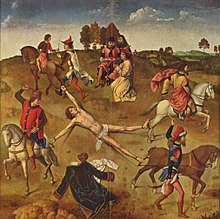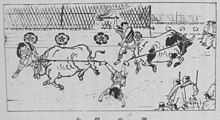Quartering

The quartering was in the Middle Ages and in the early modern period one of execution . It was particularly in attempted or vollbrachtem regicide imposed.
Description and implementation of the procedure
The execution was carried out by pulling and tearing apart the convict's arms and legs so that three of the limbs were severed from the torso . Because of the lack of resistance, the last extremity remained on the body; the delinquent was torn into the eponymous four parts. In most cases, the division into four was carried out after the convict had been killed.
In the Middle Ages and the early modern period in particular, a religious thought was added to the obvious deterrent. According to the teaching of the time, an intact body was necessary for resurrection. By dividing into quarters, the person to be executed was also to be denied a resurrection.
variants

Sometimes the executioners themselves pulled the ropes to which the convict's wrists and ankles were tied. Sometimes horses or oxen also took on this task; Sometimes this pulling force was not enough, however, and only after a long period of torture was the condemned released by the executioner helping with knife cuts (as in the case of Damien ). A pulley system could also be used to tear the victim in two while the feet were tied or weighed down.
In another variant, the arms and legs (four limbs and trunk) of the convict were sawed off or cut off (dismemberment). See also under: Lingchi .
In England in particular , this punishment was tightened by opening the convict's chest on the scaffold beforehand . Then the internal organs were taken out, shown to the delinquent and onlookers, and then burned. The hangman's skill was shown in keeping the convict alive and conscious as long as possible so that he could see his own execution. In some cases, the heart and lungs were removed before the subsequent tearing or hacking of the body, relieving the delinquent from his pain.
Cause of death
When quartered, the skin , muscles and internal organs were extremely strained . After a while, the tendons , skin, and muscles tore in two, the arms and legs were pulled, and the joints were dislocated. The victim was literally torn to pieces and died in agony from his severe injuries.
When the limbs were cut off or sawed off, the victim quickly died of bleeding to death.
Known executed people
- 1283 Dafydd ap Gruffydd
- 1305 William Wallace
- 1450 Jack Cade
- 1497 Michael An Gof , Thomas Flamank
- 1514 György Dózsa
- 1526 Jerg Ratgeb
- 1531 Huldrych Zwingli
- 1567 Wilhelm von Grumbach and Christian Brück
- 1573 Lippold Ben Chluchim , Matija Gubec
- 1577 Cuthbert Mayne
- 1584 Balthasar Gérard
- 1589 Jacques Clément
- 1594 Jean Châtel
- 1597 Seweryn Nalywajko
- 1600 Simon Bingelhelm
- 1604 Liborius Wichart , mayor of Paderborn
- 1610 François Ravaillac
- 1653 Niklaus Leuenberger
- 1671 Stenka Razin
- 1706 Johann Georg Kidler
- 1723 Christopher Layer
- 1757 Robert François Damiens
- 1771 Matthias Klostermayr
- 1772 Johann Friedrich Struensee
- 1781 José Gabriel Condorcanqui , Julián Apaza
- 1792 Joaquim José da Silva Xavier , known as Tiradentes (= tooth puller)
literature
- Horst Karasek: The division into four. How the regicide Damiens was tried in Paris in 1757. Wagenbach, Berlin 1994, ISBN 3-8031-2230-9 (literary representation based on contemporary documents)
See also
Web links
Individual evidence
- ↑ 1529 - The Turks before Vienna, documentary film by the broadcaster arte